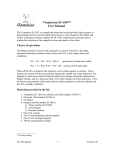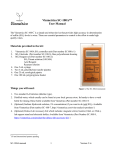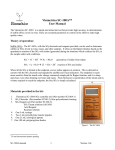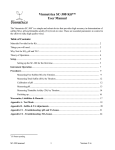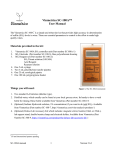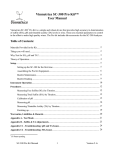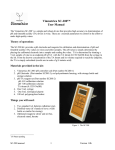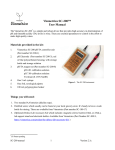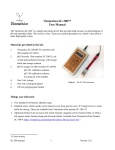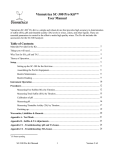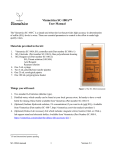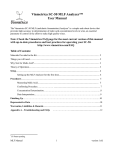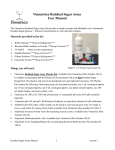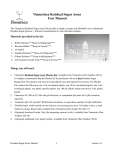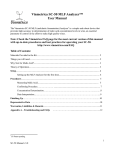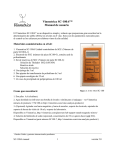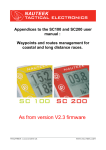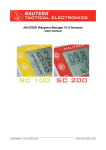Download SC-300 Manual
Transcript
Vinmetrica SC-300™ User Manual The Vinmetrica SC-300* is a simple and robust device that provides high accuracy in determination of sulfite (SO2), pH and titratable acidity (TA) levels in wine. These are essential parameters to control in the effort to make high quality wines. Theory of operation: Sulfite (SO2): The SC-300, with the SO2 electrode and reagents provided, can be used to determine sulfite (or SO2) levels in wine, musts, and other samples. It relies on the Ripper titration based on the quantitative reaction of the SO2 with iodine (generated during the titration) which oxidizes the SO2 in the sample under acid conditions. IO3- + 5I- + 6H+ 3I2 + 3H2O generation of iodine from iodate SO2 + I2 + H2O 2I- + SO3 + 2H+ reaction of SO2 and iodine When all the SO2 is titrated at the endpoint, excess iodine appears in solution. This is detected as current with the SO2 electrode and signaled by audible and visual indicators. The endpoint is much more sensitive than the starch color change commonly employed for Ripper titration, and it is sharp and clear, even when titrating red wines and musts. From the known concentration of the titrant and its volume required to reach the endpoint, the free SO2 is simply calculated. pH and TA: The SC-300 kit also provides a pH electrode and reagents for calibration and determination of pH and titratable acidity (TA) values in wines and other samples. The pH value is simply determined by placing the calibrated electrode into a sample and reading the value. TA is determined by titrating a 5 mL sample of wine to an endpoint pH of 8.2 with the TA titrant (0.13N NaOH) from the syringe in the kit. From the known concentration of the TA titrant and its volume required to reach the endpoint, the TA is simply calculated (results are in units of g/L tartaric acid). Materials provided in the kit: 1. 2. 3. 4. Vinmetrica SC-300 SO2/pH controller unit (Part number SC300-1) SO2 Electrode (Part number SC100-3), blue polycarbonate housing pH Electrode (Part number SC200-3), red polycarbonate housing SO2 Reagent set (Part number SC100-2): SO2 Titrant solution (0.0156N) Acid Reagent Reactant solution 5. pH/TA reagent set (Part number SC200-2): pH 4.01 calibration solution * US Patent pending SC-300 manual 1 Version 1.3b pH 7.00 calibration solution TA titrant (0.13 N NaOH) 6. Two 5 mL syringes 7. Two 3 mL polyethylene transfer pipettes 8. One 25 mL serological pipette 9. One 5mL serological pipette 10. 100 mL polypropylene beaker Things you will need: 1. Two standard AA batteries (alkaline type). 2. Distilled water (it’s handy to have a wash bottle or similar for rinsing) 3. (Optional) magnetic stirrer and stir bar, electrode stand, Figure 1. The SC-300 burette 4. (Optional) Sodium Hydroxide solution, 1N concentration (if you want to do total SO2). Available from Vinmetrica (Part number SC100-7) Setting up the instrument: 1. The SC-300 (Figure 1) runs on two standard AA batteries (alkaline cells recommended). To insert the batteries, open the battery housing on the bottom of the back of the unit by removing the two screws and gently prying off the lid. Install the batteries as shown by the + and – markings, then close the housing. If desired, you can prop the unit up using its folding stand. Low Battery Detection:When the battery level is getting low, the instrument shows a low battery icon on the upper left side of the display but continues to operate without impairment to any function. Replace the batteries as soon as practicable. When the battery level drops too far, the instrument does not operate. It rapidly flashes the low battery icon for 3.0 seconds, beeps and shuts itself off. Auto Shut-off: The SC-300 shuts off after 30 minutes. If this happens unexpectedly, just press the POWER button to resume from where you were. 2. Electrodes: Attach the desired electrode (pH or SO2, see below) via the BNC connector protruding from the top. SO2 electrode: Remove any protective cover from the electrode tip (some electrodes are shipped without one). Put the electrode on its side, or hang it from an electrode stand if you have one. The SO2 electrode (blue) is sturdy with its plastic housing, but do take care not to let things touch or strike the platinum wires; they are somewhat fragile and will break if bent and straightened repeatedly. Electrode care: when done, always rinse with DI water and let air dry. There is no need to store the electrode in any kind of solution. pH electrode: Attach the pH electrode via the BNC connector protruding from the top. A note about the pH electrode: The pH electrode is fragile and should always be handled carefully. Remove the liquid storage bottle by unscrewing the cap FIRST, then gently pulling the bottle, followed by the cap, off the electrode. Rinse the electrode in a little distilled water before each use. Electrode care: Do not touch the glass bulb, nor attempt to wipe it with anything. When necessary, you may gently blot excess liquid away from the electrode surface, but avoid directly touching it. The pH electrode should always be kept in the liquid storage bottle with its special SC-300 manual 2 Version 1.3b solution (available from Vinmetrica) when not in use. Rinse the electrode with DI water and gently blot or shake off excess water. Push the electrode through the hole in the cap about an inch, then gently screw the bottle onto the cap so that the electrode is in contact with the solution in the bottle. OPERATION: Turn on the instrument by pressing the POWER button briefly. (Note: depressing the POWER button longer than two seconds at start-up will cause the instrument to enter Test Mode; see Appendix) The instrument will go through a power-up sequence. After a few seconds the instrument will start in whatever mode was last selected. The mode is indicated by the yellow LED panel on the left. Select the desired mode by pressing the MODE button. 1. SO2 mode This is for titration in determining ppm of SO2 (see below under Titration procedures). The SO2 electrode must be attached [Warning: The pH electrode can be damaged by connecting it to the instrument in SO2 mode.] As a safety precaution, you must press the ENTER button after selecting SO2 mode to confirm that the SO2 electrode is attached before the mode will be enabled. However, scrolling through the MODE selections (such that you pass by the SO2 selection) with a pH electrode attached is safe, as long as you do not press ENTER to confirm the SO2 mode. 2. You should see the display show a value less than 50 (usually 0.0) and the green (Proceed) LED should be on. 3. pH mode: In this mode, the meter measures the pH. The pH electrode must be attached. If the instrument has not yet been calibrated, the message “doCal” scrolls across the screen, and you need to do a calibration (see below). We recommend re-calibrating the instrument for pH once each day of use. 4. TA mode: This is for titration in determining titratable acidity. As in the pH mode, the pH is displayed and the pH electrode must be attached.. The green “Proceed” LED is lit if the pH is below 8.2, while the red STOP LED is lit if the pH is 8.2 or greater. (see below under Titration procedures) 5. CAL mode: This is for calibrating the pH electrode, which must be attached. The display initially shows CAL for a few seconds as it prepares to read pH and lets readings settle. Thereafter, the display shows the measured pH level with two decimal places. 6. Calibration works with one of the following calibration sets: pH 4.01 and 7.00 or “4/7” pH 7.00 and 10.00 or “7/10” pH 3.00 and 7.00 or “3/7” Vinmetrica recommends use of the 4/7 set provided with the kit. SC-300 manual 3 Version 1.3b Procedures Calibration of pH: 1. Be sure the pH electrode is attached to the unit, then select CAL mode by pressing the MODE button until the CAL LED illuminates. 2. Choose a calibration set that corresponds to the range you are working in. Usually for wine this will be at pH values below 4, so use the 4/7 set. If you have a source of a pH 3.00 reference solution, you can use this in place of pH 4. 3. Rinse the electrode with DI water, shake off excess liquid gently, and place the electrode into a small vessel containing either member of one calibration set (e.g. pH 4.01 ). 4. The instrument will determine which calibration solution is being used, and will display the apparent pH value. When the pH level is sensed as stable, the nominal value is shown on the display, flashing, and the “CAL” LED flashes to convey that calibration for this value is ready. Press the ENTER button to accept the calibration. 5. The display stops flashing, scrolling the message Good Cal, and four beeps are rapidly sounded to indicate success. [Note: if an error occurs during this process, the message Bad Cal will scroll and a single beep will sound; the instrument will then continue to wait for a stable pH level. Repeat step 4.] 6. Now rinse the electrode again and place it in the second member of the calibration set (e.g., pH 7.00). Repeat the process to get a second Good Cal message. Exit into pH or TA mode. Measuring pH: 1. Make sure the pH electrode is attached. Calibrate it as described above if necessary. Select pH mode with the MODE button. 2. Rinse the pH electrode with DI water. Gently shake off or carefully blot away excess liquid. 3. Place the electrode in the solution to be tested. Be careful not to let the electrode strike any surfaces. 4. Allow the pH reading to stabilize. Typically this takes about 10-15 seconds. Read the pH value on the display. SC-300 manual 4 Version 1.3b Titration procedures for TA and SO2 Titratable Acidity (TA) 1. If you are working with a sample of must, we recommend homogenizing your sample in a blender before proceeding; otherwise your TA values can be very inaccurate. Take 100 mL or more of your must and put it in a blender on high for 30 seconds. Allow solids to settle for 2 minutes before sampling. 2. Fill the syringe by drawing up the TA Titrant (0.133N NaOH). Expel bubbles and set the plunger on the syringe to a readable point, preferably the 5.0 mL point. [Note: the 5.0 mL setting allows determination of up to 10 g/L TA in a standard 5 mL wine sample.] If you are using a buret instead, fill it now. Caution: the TA Titrant (0.133N NaOH) is caustic and can cause damage to clothing, skin and eyes. We recommend use of laboratory safety glasses and latex or nitrile gloves during this procedure. If any solutions contact skin or eyes, flush with plenty of water. 3. Place 5.0 mL wine or must in the titration vessel (100 mL polypropylene beaker). We recommend using the 5 mL pipette provided in the kit: draw sample up to the 0 mL mark, then dispense the sample into your titration vessel by letting the tip of the pipette touch the side of the vessel while the sample drains. For best accuracy, do not blow out the liquid that remains in the tip. Add about 15 ml of DI water. 4. Turn on the instrument. Make sure the pH electrode is attached. If necessary, calibrate it as described above. Select TA mode with the MODE button. 5. If you are using a magnetic stirrer, turn it on to stir at a moderate rate. Be sure the stir bar will not strike the electrode in the next step. 6. Rinse the electrode briefly with distilled water. Insert the electrode into the titration vessel so that the tip is completely submerged to just above the circulation gaps (cutouts at the tip of the electrode). 7. If you are stirring manually, begin now; use a moderate swirling motion. If the electrode is not held in a stand, hold it against the side of the vessel with one finger and grasp the vessel with the remaining fingers so that the two move together. (Figure 2) 8. Verify that the pH is less than 7 and the green (“PROCEED”) LED is lit. If the pH is greater than this, and/or the red (“STOP”) LED is lit and the beeper sounds, your sample has less than 0.1g/L TA and there is no need to proceed. 9. Titrate the sample by adding the TA Titrant dropwise from the syringe or buret, being sure to note the starting volume mark on the syringe or buret. During the titration, the pH will gradually rise from its starting value (below 4 usually). As you approach pH 7, go slowly in adding successive drops of titrant so as not to overrun the endpoint. Be sure to mix thoroughly after each successive drop of titrant. Take the endpoint as the first addition of TA Titrant that causes the pH to stay above 8.2 for longer than 15 seconds. The STOP LED and the beeper will provide additional indication of the endpoint. Read the endpoint volume off of the syringe or buret. To silence the beeper after the endpoint, select pH mode, or turn off the instrument. 10. Calculate the TA value as V * 0.133 * 75 TA (g/L tartaric) = S where V = mL Titrant needed to reach the endpoint; N = normality of the Titrant, S = mL sample. If you use 5 mL of sample as directed, and the Titrant is 0.133 N as supplied, then the calculation is simply TA = 2 * V (i.e. 2 times V) SC-300 manual 5 Version 1.3b Titration Procedures - SO2 Free SO2 1. Make sure the SO2 electrode is attached. Turn on the instrument and select SO2 mode with the MODE button. Press ENTER to confirm selection of SO2 mode. 2. Fill the syringe by drawing up the SO2 Titrant. Expel bubbles and set the plunger on the syringe to a readable point, preferably the 5.0 mL point. [Note: the 5.0 mL setting allows determination of up to 100 ppm SO2 in a standard 25 mL wine sample.] If you are using a buret instead, fill it now. 3. Place 25 mL wine or must in the titration vessel. We recommend using the 25 mL pipette provided in the kit: draw sample up to the 0 mL mark, then dispense the sample into your titration vessel by letting the tip of the pipette touch the side of the vessel while the sample drains. 4. Using the transfer pipettes, add about 2 mL Acid Reagent and 2 mL Reactant solution to the vessel. It is not necessary to be extremely accurate in this step; with these pipettes, 2 mL is roughly the amount that fills the bulb with a single thorough squeeze. Caution: the Acid reagent is corrosive and can cause damage to clothing, skin and eyes. The Reactant solution should not be ingested. We recommend use of laboratory safety glasses and latex or nitrile gloves during this procedure. If any solutions contact skin or eyes, flush with plenty of water. 5. If you are using a magnetic stirrer, turn it on to stir at a moderate rate. Be sure the stir bar will not strike the electrode in the next step. 6. Rinse the electrode briefly with distilled water. Insert the electrode into the titration vessel so that the tip is completely submerged to just above the circulation gaps (cutouts at the tip of the electrode). 7. If you are stirring manually, begin now; use a constant moderate swirling motion. If the electrode is not held in a stand, hold it against the side of the vessel with one finger and grasp the vessel with the remaining fingers so that the two move together. (Figure 2) Figure 2. Manual stirring technique. Hold the electrode against the side of the vessel and swirl gently; add titrant with other hand. SC-300 manual 6 Version 1.3b 8. Verify that the current is less than 50 and the green (“PROCEED”) LED is lit. If the current is greater than this, and/or the red (“STOP”) LED is lit and the buzzer sounds, your sample has less than 2 ppm SO2 and there is no need to proceed. 9. Titrate the sample by adding the SO2 Titrant dropwise from the syringe or buret, being sure to note the starting volume mark on the syringe or buret. Try to accomplish the titration as rapidly as possible (in 2 minutes or less), but be careful near the endpoint so as not to overrun it – here, dispense one or two drops at a time. Be sure to maintain stirring or swirling throughout the entire procedure. 10. During the titration, the LCD display will show transient currents, the red STOP LED will briefly illuminate, and the beeper will sound (“beep-beep!”). These transient indicators will last longer and longer as you approach the endpoint. Take the endpoint as the first addition of Titrant that causes the display to exceed 50, and the red LED and beeper to stay on, for longer than 15 seconds (or a count of 20 “beep-beeps”). It is important to maintain stirring or swirling to detect the endpoint well. Read the endpoint volume off of the syringe or buret. 11. The free SO2 content is calculated as ppm SO2 = 64 * V * N * 1000 2*S where V = mL Titrant needed to reach the endpoint; N = normality of the Titrant, S = mL sample. 1 If you use 25 mL of sample as directed, and the Titrant is 0.0156 N as supplied, then the calculation is simply ppm SO2 = 20 * V (i.e. 20 times V) For total SO2 1. Place 25 mL wine or must in the titration vessel. 2. Add 10ml 1N sodium hydroxide and mix well. Let stand approximately 10 minutes. 3. Using the transfer pipettes, add 8 mL Acid Reagent and 2 mL Reactant solution to the vessel. Remember that if you are using the transfer pipettes in the kit, 2 mL is the amount that fills the bulb with a vigorous squeeze, so dispense four of these for the Acid Reagent. 4. Proceed from step 5 in the Free SO2 procedure above. The result calculated will be total, rather than free, ppm SO2. 1 64 [mg SO2/mmol SO2 ]* V [mL] * N [meq/mL] * 1000 [mL/L] 2 [meq/mmol SO2] * S [mL] SC-300 manual 7 Version 1.3b Finishing up: 1. 2. 3. 4. 5. Turn off the instrument. Rinse the SO2 electrode and syringe with distilled water. Let air dry. Be sure to rinse and store the pH electrode as directed on page 2. Store all reagents tightly capped and away from heat and sunlight. Discard waste samples and solutions in accordance with local regulations. Acidic solutions can be neutralized by slow addition of baking soda (sodium bicarbonate) with stirring until effervescence ceases. Technical assistance: [email protected] tel. 760-494-0597 WARRANTIES AND LIABILITIES 1. The materials provided in the kit, as described on pages 1 and 2 above, (“Materials”) are warranted as follows: The SC-300 instrument, electrodes and non-reagent accessories are warranted against defects in workmanship for 12 months from date of purchase. The reagents are warranted to perform as described herein up until any stated expiration date or 6 months after purchase, whichever is later. THE WARRANTIES IN THESE TERMS AND CONDITIONS ARE IN LIEU OF ALL OTHER WARRANTIES, EXPRESS OR IMPLIED, INCLUDING WITHOUT LIMITATION ANY WARRANTIES OF MERCHANTABILITY, NONINFRINGEMENT, OR FITNESS FOR A PARTICULAR PURPOSE, SAID WARRANTIES BEING EXPRESSLY DISCLAIMED. 2. Buyer agrees that its sole and exclusive remedy against Vinmetrica shall be limited to the repair and replacement of Materials or parts of Materials, provided Vinmetrica is promptly notified in writing, prior to the expiration of the warranty period specified above, of any defect. Vinmetrica’s liability for any damages due Buyer shall be limited to the purchase price of the Materials. 3. VINMETRICA'S MAXIMUM LIABILITY FOR ALL DIRECT DAMAGES, INCLUDING WITHOUT LIMITATION CONTRACT DAMAGES AND DAMAGES FOR INJURIES TO PERSONS OR PROPERTY, WHETHER ARISING FROM VINMETRICA’S BREACH OF THESE TERMS AND CONDITIONS, BREACH OF WARRANTY, NEGLIGENCE, STRICT LIABILITY, OR OTHER TORT WITH RESPECT TO THE MATERIALS, OR ANY SERVICES IN CONNECTION WITH THE MATERIALS, IS LIMITED TO AN AMOUNT NOT TO EXCEED THE PRICE OF THE MATERIALS. IN NO EVENT SHALL VINMETRICA BE LIABLE TO BUYER FOR ANY INCIDENTAL, CONSEQUENTIAL OR SPECIAL DAMAGES, INCLUDING WITHOUT LIMITATION LOST REVENUES AND PROFITS. HAZARDS AND TOXICITY All Materials offered by Vinmetrica are intended for use by individuals who are familiar with laboratory procedures and their potential hazards. The Materials contain chemicals which may be harmful if misused. Due care should be exercised with all Materials to prevent direct human contact. Keep out of reach of children. Vinmetrica 1945 Camino Vida Roble, Suite E - Carlsbad, CA 92008 .www.vinmetrica.com (760) 494-0597 [email protected] Copyright 2010-12. Sportsman Consulting, LLC DBA Vinmetrica. All rights reserved. SC-300 manual 8 Version 1.3b Appendix Test Mode Test Mode provides various special functions that may be useful in testing the device, for example, if troubleshooting is necessary. • Test Mode is entered when the POWER button is pressed longer than 2 seconds while turning the instrument on. Remove the pH electrode if it is attached. • Test Mode is organized into sections. Press the POWER button briefly to move to the next section. After the last section, Test Mode restarts the first. WARNING! DO NOT MOVE THROUGH SECTIONS WITH THE pH PROBE ATTACHED! This can damage the electrode. Only connect the pH electrode if needed in section 2 or 4. Always remove the pH electrode before leaving these sections. • Combinations of the yellow MODE LEDs are illuminated to indicate the section number as shown in the table below. • The Stop LED (red) is illuminated when an error is detected by the instrument The Proceed LED (green) is illuminated to indicate no error detected. The green LED does not guarantee proper functioning; it only indicates that no problem could be automatically detected. The user should make careful observations to discern proper operation. • To exit Test Mode, hold the POWER button down (5-10 seconds) until the instrument shuts off. If the device does not shut off after 10 seconds of holding down the button, move to the next section by releasing, then pressing again the POWER button briefly; then try to exit again. Yellow Section LEDs 0. Version Equipment Required None. Description The version number of the instrument software is displayed. The instrument goes through a continuous “burn-in” cycle, exercising relay, sound, LEDs, and display. 1. Burn-in None 2. pH pH probe or precision voltage source. Do not exceed +/- 0.5 V. An uncalibrated pH level is shown in two alternating parts. First, the integer portion of pH level is shown (1 to 14). Next, three decimal places are shown. Readings above 14.000 are shown as "---". Readings below 0.000 are shown as " ___". 3. SO2 SO2 probe or SO2 probe simulator ( e.g., 450 kOhm resistor) The SO2 current in nanoamperes is displayed. For values under 10, one decimal place is shown. 4. pH Voltage pH probe or precision voltage source. Do not exceed +/- 0.5 V. The raw voltage output from the instrument's pH amplifier is displayed as X.XX volts. Readings can range from 0.00 to 4.10. SC-300 manual 9 Version 1.3b Yellow Section LEDs Equipment Required Description 5. SO2 Voltage SO2 probe or SO2 probe simulator. The raw voltage output from the instrument's current amplifier is displayed as X.XX volts. (.XXX if less than 1.00) 6. DAC Test None. Disconnect probe. The Digital-Analog Converter (DAC) is cycled through its 32 levels. 7. Battery Voltage Install two AA batteries The battery voltage is displayed as X.XX volts. 8. Character None. Set Every ASCII character (space) to ~ is displayed. Due to the limitations of the 7-segment format, some characters are not used by the software. 9. Number Display None. The display cycles through showing every possible digit and every decimal point. 10. Sound Test None. The beeper is turned on continuously. SC-300 manual 10 Version 1.3b










